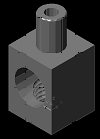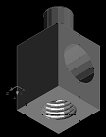Design, Construction And Testing Of Tooling To Be Used With A Vibratory Bowl Feeder
Abstract Category: Engineering
Course / Degree: B.Eng. (Hons.)
Institution / University: University of Malta, Malta
Published in: 2002
Background
Automation has been essential in the development of fast and efficient production in manufacturing industries. Part feeding is an important element in an automated system. It involves in orienting the parts and feeding them in such a way that these can be easily manipulated by the automated system. Vibratory bowl feeders are often used to solve these types of problems. The project involves the development of the tooling required to orientate a particular component on a bowl feeder. A mechanical gripper can then easily pick up these parts. The thesis involves in producing a conceptual design of the tooling, constructing the tooling, testing it (and modifying it as necessary), and implementing it with the vibratory bowl feeder. Finally testing on the feeding rate of the system is performed.
The vibratory bowl feeder is one of the most versatile of hopper feeding devices for small engineering parts. Vibratory bowl feeders usually have a helical track along which the parts travel and pass around the inside of the wall of a shallow cylindrical bowl or hopper. Generally the bowl is supported on a set of inclined leaf springs secured to a heavy base. An electromagnet mounted on the base applies vibration to the bowl, and the support system constrains the movement of the bowl so that it has a torsional vibration about its vertical axis coupled with a linear vertical vibration. This type of vibration produces a motion (of the part), which is such that any part of the inclined track vibrates along a short approximately straight part, which is inclined to the horizontal at a greater angle than that of the track. The effect of the vibratory motion is such to cause the parts to climb up the track to the outlet at the top of the bowl.
Objective
The parts that are going to be used for the thesis are small terminals that are used by ‘METHODE MALTA’, a local company that produces car terminals. These are quite small (approximately 6mm X 6mm X 12mm). The parts consist of a pin on the upper part of the terminal as shown in the diagram below, a through hole on the side of the terminal, and a threaded hole on the lower side of the terminal. The company identifies each component/part by a number. This particular terminal identification number is 10013.
The hard goal requirements were: a) Provide correctly oriented parts at workhead,
b) Reliability, c) repeatability.
The soft goal was to have the highest feed rate possible.
The constraint was that there should be no non-oriented parts at the workhead.
Project Methodology
The most difficult part, when trying to come out with a good design is when one needs to bring out ideas and how to structure his/her work. The ‘basic design cycle’ produced by Hall helps to structure the design process. Therefore this methodology was used. The ‘basic design cycle ’mainly consists of the following six steps:
1. Recognition of need
2. Definition of problem
3. Synthesis
4. Analysis and optimisation
5. Evaluation
6. presentation
Results and achievement
It can be shown that approximately 23 % of the initial part orientations are accepted. The remainder 77% are rejected back into the bowl feeder. Also the feeding rate was found to be adequate.
However further testing is still being carried which can lead to some minor modifications of the track. To maximise the feed rate, one has to maximise the amplitude of the vibration, since these two parameters are proportional. However increasing the amplitude will lead to a more chaotic line up of the parts. Further modifications of the tooling can lead to maximise the amplitude of vibration without the parts behaving erroneously.
Thesis Keywords/Search Tags:
tooling, mechanical engineering
This Thesis Abstract may be cited as follows:
Ellul, S. (2002), Design, Construction And Testing Of Tooling To Be Used With A Vibratory Bowl Feeder, Unpublished B.Eng. (Hons.) Dissertation, May 2003, Faculty of Engineering, University of Malta
Submission Details: Thesis Abstract submitted by Stephen Ellul from Malta on 25-Apr-2004 21:14.
Abstract has been viewed 3994 times (since 7 Mar 2010).
Stephen Ellul Contact Details: Email: aellul@onvol.net
Disclaimer
Great care has been taken to ensure that this information is correct, however ThesisAbstracts.com cannot accept responsibility for the contents of this Thesis abstract titled "Design, Construction And Testing Of Tooling To Be Used With A Vibratory Bowl Feeder". This abstract has been submitted by Stephen Ellul on 25-Apr-2004 21:14. You may report a problem using the contact form.
© Copyright 2003 - 2025 of ThesisAbstracts.com and respective owners.



